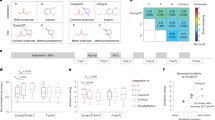Abstract
No two roses smell exactly alike, but our brain accurately bundles these variations into a single percept 'rose'. We found that ensembles of rat olfactory bulb neurons decorrelate complex mixtures that vary by as little as a single missing component, whereas olfactory (piriform) cortical neural ensembles perform pattern completion in response to an absent component, essentially filling in the missing information and allowing perceptual stability. This piriform cortical ensemble activity predicts olfactory perception.


Similar content being viewed by others
References
Hasselmo, M.E. Trends Cogn. Sci. 3, 351–359 (1999).
Leutgeb, J.K., Leutgeb, S., Moser, M.B. & Moser, E.I. Science 315, 961–966 (2007).
Marr, D. Phil. Trans. R. Soc. Lond. B 262, 23–81 (1971).
O'Reilly, R.C. & McClelland, J.L. Hippocampus 4, 661–682 (1994).
Treves, A. & Rolls, E.T. Hippocampus 2, 189–199 (1992).
Hebb, D.O. The Organization of Behavior: a Neuropsychological Theory (John Wiley, New York, 1949).
Lin, D.Y., Shea, S.D. & Katz, L.C. Neuron 50, 937–949 (2006).
Polak, E.H. J. Theor. Biol. 40, 469–484 (1973).
Wilson, D.A. & Stevenson, R.J. Learning to Smell: Olfactory Perception From Neurobiology to Behavior (Johns Hopkins University Press, Baltimore, Maryland, 2006).
Hopfield, J.J. Proc. Natl. Acad. Sci. USA 88, 6462–6466 (1991).
Haberly, L.B. Chem. Senses 26, 551–576 (2001).
Laing, D.G. & Francis, G.W. Physiol. Behav. 46, 809–814 (1989).
Wilson, D.A. J. Neurophysiol. 90, 65–72 (2003).
Bakker, A., Kirwan, C.B., Miller, M. & Stark, C.E.L. Science 319, 1640–1642 (2008).
Silva Ferreira, A.C., Hogg, T. & Guedes de Pinho, P. J. Agric. Food Chem. 51, 1377–1381 (2003).
Acknowledgements
This work was funded by grant R01-DC03906 to D.A.W. and grant R01-DC008982 to R.L.R and D.A.W. from the US National Institute on Deafness and other Communication Disorders.
Author information
Authors and Affiliations
Contributions
D.C.B., R.D.H., A.R.Z., R.L.R. and D.A.W. collected and analyzed the data. D.A.W. designed the experiments and wrote the manuscript.
Corresponding author
Supplementary information
Supplementary Text and Figures
Supplementary Figures 1 and 2, Supplementary Tables 1 and 2, Supplementary Methods and Supplementary Results (PDF 849 kb)
Rights and permissions
About this article
Cite this article
Barnes, D., Hofacer, R., Zaman, A. et al. Olfactory perceptual stability and discrimination. Nat Neurosci 11, 1378–1380 (2008). https://doi.org/10.1038/nn.2217
Received:
Accepted:
Published:
Issue Date:
DOI: https://doi.org/10.1038/nn.2217
- Springer Nature America, Inc.
This article is cited by
-
Endogenous cannabinoids in the piriform cortex tune olfactory perception
Nature Communications (2024)
-
Robust odor identification in novel olfactory environments in mice
Nature Communications (2023)
-
Olfactory impairment in men and mice related to aging and amyloid-induced pathology
Pflügers Archiv - European Journal of Physiology (2021)
-
Bilateral and unilateral odor processing and odor perception
Communications Biology (2020)
-
Structure and flexibility in cortical representations of odour space
Nature (2020)





